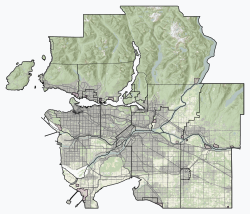
The Vancouver Art Gallery (VAG) is an art museum in Vancouver, British Columbia, Canada. The museum occupies a 15,300-square-metre-building (165,000 sq ft) adjacent to Robson Square in downtown Vancouver, making it the largest art museum in Western Canada by building size. Designed by Francis Rattenbury, the building the museum occupies was originally opened as a provincial courthouse, before it was re-purposed for museum use in the early 1980s. The building was designated the Former Vancouver Law Courts National Historic Site of Canada in 1980.

The Morris and Helen Belkin Art Gallery is a contemporary art gallery in Vancouver, British Columbia, on the campus of the University of British Columbia. The gallery is housed in an award-winning building designed by architect Peter Cardew and opened in 1995. It houses UBC's growing collection of contemporary art as well as an archives containing objects and records related to the history of art in Vancouver.
"Paul Wong is a Canadian multimedia artist. An artist, curator, and organizer of public interventions since the mid-1970s, Wong is known for his engagement with issues of race, sex, and death. His work varies from conceptual performances to narratives, meshing video, photography, installation, and performance with Chinese-Canadian cultural perspectives".

Bob Rennie is an art collector and a real estate marketer based in Vancouver, British Columbia. He is the founder and executive director of Rennie, which is one of Vancouver's largest real estate marketing firms. The company's business divisions include Rennie developer services, Rennie consumer services, Rennie advisory services, Rennie rental services, technology and more. Some of Rennie's top competitors include Key Marketing, MLA Canada, and Magnum Projects. He is known colloquially as the "condo king". Nominated by ArtNews Magazine as one of the top 200 collectors in the world, Rennie is deeply involved in the art community locally and internationally, and he maintained his own art museum in Chinatown's Wing Sang building until fairly recently gifting it to the Chinese History Society.
Elizabeth McIntosh is a Canadian painter. Her work explores geometric abstraction. Her work is in the permanent collection of the National Gallery of Canada and Art Gallery of Ontario. She lives and works in Vancouver.
Marina Roy is a visual artist, educator and writer based in Vancouver, British Columbia.
Lorna Brown is a Canadian artist, curator and writer. Her work focuses on public space, social phenomena such as boredom, and institutional structures and systems.
Jamelie Hassan is a Canadian multidisciplinary artist, lecturer, writer and independent curator.
Deanna Bowen is an interdisciplinary artist whose practice includes films, video installations, performances, drawing, sculpture and photography. Her work addresses issues of trauma and memory through an investigation of personal and official histories related to slavery, migration, civil rights, and white supremacy in Canada and the United States. Bowen is a dual citizen of the US and Canada. She lives and works in Montreal.
Taslim Samji is a Canadian interdisciplinary artist, writer and curator based in Burnaby, British Columbia.
Laiwan is a Zimbabwean interdisciplinary artist, art critic, gallerist, writer, curator and educator. Her wide-ranging practice is based in poetics and philosophy. She lives in Vancouver, British Columbia.

Arabella Campbell is a Canadian artist based in Vancouver, British Columbia. She graduated with a Bachelor of Arts from the University of British Columbia in 1996, and a Bachelor of Fine Arts from Emily Carr University of Art and Design in 2002. She attended the San Francisco Art Institute from 1998 to 2000. She has exhibited locally, nationally, and internationally. She works out of a warehouse studio in False Creek Flats, Vancouver.
Sylvia Grace Borda is a Canadian artist working in photography, video and emergent technologies. Borda has worked as a curator, a lecturer, a multimedia framework architect with a specialization in content arrangement (GUI) and production. Born and raised in Vancouver, Borda is currently based in Vancouver, Helsinki, and Scotland. Her work has been exhibited locally, nationally, and internationally.
Brenda Draney is a contemporary Cree artist based in Edmonton, Alberta.
Cecily Nicholson is a Canadian poet, arts administrator, independent curator, and activist. Originally from Ontario, she is now based in British Columbia. As a writer and a poet, Nicholson has published collections of poetry, contributed to collected literary works, presented public lectures and readings, and collaborated with numerous community organizations. As an arts administrator, she has worked at the Surrey Art Gallery in Surrey, British Columbia, and the artist-run centre Gallery Gachet in Vancouver.

Daina Warren is a Canadian contemporary artist and curator. She is a member of the Montana Akamihk Cree Nation in Maskwacis, Alberta. Her interest in curating Aboriginal art and work with Indigenous artists is at the forefront of her research.
Âhasiw Maskêgon-Iskwêw (1958–2006) was a Cree and French Métis theorist, curator and artist. Maskêgon-Iskwêw was a significant figure in the field of contemporary Indigenous arts, and a formative proponent of digital media within Indigenous communities. In their 2015 book dedication to him, Steven Loft and Kerry Swanson describe Maskêgon-Iskwêw as "one of the foremost thinkers and practitioners of Aboriginal new media art."
Denise Ryner is a Canadian curator and writer. She was director and curator at Or Gallery, Vancouver (2017-2022). Ryner has worked as an independent curator, writer and educator at several galleries, artist-run centres and institutions, in Toronto, Vancouver and Berlin. Ryner has contributed to publications like FUSE magazine and Canadian Art magazine.
Chantal Gibson is a Canadian writer, poet, artist and educator. Her 2019 poetry collection How She Read won the 2020 Pat Lowther Award, the 2020 Dorothy Livesay Poetry Prize at the BC and Yukon Book Prizes, and was a shortlisted 2020 Griffin Poetry Prize finalist. Gibson’s art and writing confronts colonialism, cultural erasure, and representations of Black women in Western culture.
Doris Shadbolt, née Meisel LL. D. D.F.A. was an art historian, author, curator, cultural bureaucrat, educator and philanthropist who had an important impact on the development of Canadian art and culture.








